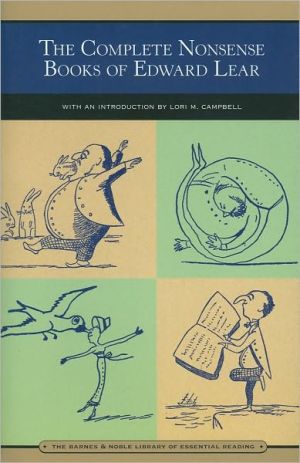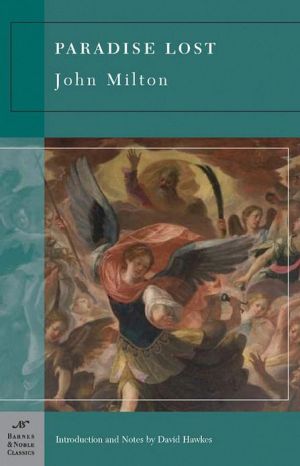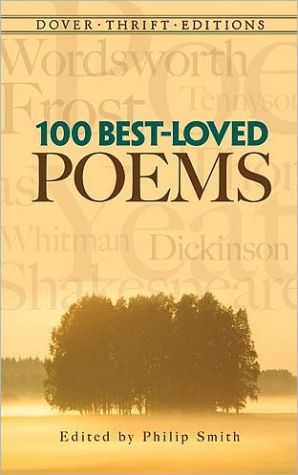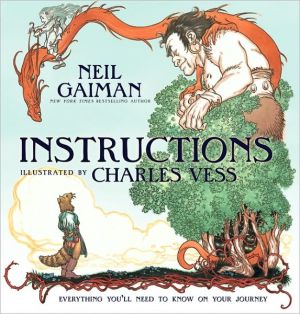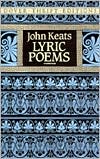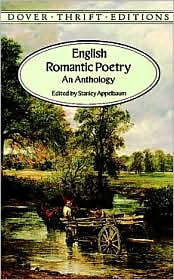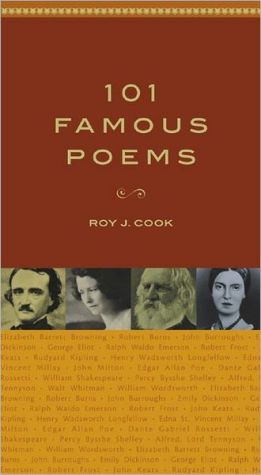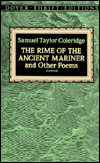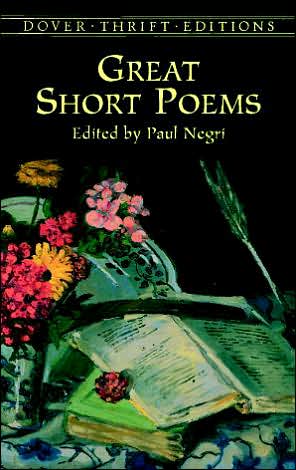The Complete Nonsense Books of Edward Lear (Library of Essential Reading)
This comprehensive volume includes all of Edward Lear’s best-loved works, from Queery Leary Nonsense and The Book of Nonsense to Nonsense Songs and Stories, Laughable Lyrics, and Nonsense Alphabets. Find out why “The Daddy Long-Legs and the Fly” believe “the world has all gone wrong.” Take a journey in a “pea-green boat” with “The Owl and the Pussy-cat.” Travel to where “The Jumblies” live and explore “The History of the Seven Families of the Lake Pipple Popple.” Lear’s rhymes have brought...
Search in google:
This comprehensive volume includes all of Edward Lear's best-loved works from Queery Leary Nonsense and The Book of Nonsense to Nonsense Songs and Stories, Laughable Lyrics, and Nonsense Alphabets. Find out why the Daddy Long-Legs and the Fly believe "the world has all gone wrong." Take a journey in a "pea-green boat" with the Owl and the Pussy-Cat. Travel to where the Jumblies live and explore the history of the seven families of the Lake Pipple Popple. Lear's rhymes have brought smiles to generations of children, but his nonsense also offers adults a satirical commentary on human nature that continues to be thought-provoking and relevant today.
Edward Lear (1812–1888) was a naturalist, artist, and world traveler whose voluminous letters and journals are filled with comic sketches, made-up words, and general silliness that spilled into the genre he made famous. This comprehensive Barnes and Noble edition spans Lear’s career and includes all of his best-loved work, from Queery Leary Nonsense and The Book of Nonsense to Nonsense Songs and Stories, Laughable Lyrics, and Nonsense Alphabets. Find out why “The Daddy Long-Legs and the Fly” believe “the world has all gone wrong.” Take a journey in a “pea-green boat” with “The Owl and the Pussy-cat.” Travel to where “The Jumblies” live and explore “The History of the Seven Families of the Lake Pipple Popple.” Lear’s rhymes have brought smiles to generations of children, but his nonsense also offers adults a satirical commentary on human nature that continues to be thought provoking and relevant today. Lear took his nonsense quite seriously, perhaps because it provided such freedom to deal with his own anxieties while injecting humor into his chaotic Victorian society. This intriguing collection will undoubtedly charm while also providing a fascinating glimpse into the psyche of a “scroobious” wordsmith and enigmatic Person who will forever be known as “The Prince of Nonsense.” And more important—it’s just plain fun!\ Born May 12, 1812, the same year as Charles Dickens and Robert Browning, Edward Lear was the twentieth of the twenty-one children of stockbroker Jeremiah Lear and Ann Skerrett. He spent his first four years in relative affluence at Bowman’s Lodge in the London suburb of Holloway, but in 1816 Jeremiah’s financial difficulties led to legal trouble, compelling the family to seek less expensive accommodations. Lear’s mother entrusted him to the care of his eldest sister Ann, instilling a sense of abandonment and inadequacy that played out later in characters such as “The Dong with a Luminous Nose” (Lear was known for feeling self-conscious about the size of his nose). Apart from a brief period of formal schooling at about age eleven, Lear received the majority of his education from Ann. From about age five, Lear suffered epilepsy, or “The Demon” as he refers to it in his diaries, with a side effect of “The Morbids,” his term for bouts of depression that started at seven and recurred throughout his life. Although his sister Jane was also epileptic, Lear felt ashamed, probably due to a folk belief that such attacks were caused by masturbation. He devised a way to seek solitude when he perceived an oncoming attack, and never mentioned the illness in his letters, so his friends did not find out he suffered from the condition until after his death when his diaries came to light.[i]\ Lear never married but came close at least twice. His most serious consideration, of Augusta “Gussie” Bethell, came to naught as Lear “simply could not make up his mind”[ii] and she married another man. Lear’s epilepsy and possible homosexuality are cited as deciding factors in his bachelorhood. The debate over his sexuality fuels the enigma of his character. Critics such as Jean-Jacques Lecercle, Ina Rae Hark, and his most authoritative biographer, Vivien Noakes, suggest Lear was gay but celibate, while Peter Levi, Kirby Olson, and others remain far less certain. In Comedy after Postmodernism: Rereading Comedy from Edward Lear to Charles Willeford (2001), Olson likely comes closest to the mark, claiming, “Lear defies definition and any attempt to squeeze him into any of the sexual typologies currently available . . . seem[s] doomed to be inconclusive.”[iii] We know from his surviving letters and diaries that Lear cherished his friendships with men and women, especially Chichester Fortescue, Frank Lushington, and Alfred Lord Tennyson’s wife, Emily. On his deathbed, Lear’s last words to a servant conveyed a message to his closest male companions: “My dear Giuseppi, I feel I am dying. You will do me a sacred service with my friends if you tell them that my last thought was of them, especially the Judge [Lushington] and Lord Northbrook [Thomas Baring] and Lord Carlingford [Fortescue]. I cannot find words sufficient to thank my good friends for the good they have always done me.”[iv] Following his beloved cat, Foss, by only three months, Lear passed away peacefully in San Remo, Italy, in 1888.\ Lear was drawn to the creative arts as a child when Ann and another sister, Sarah, taught him to draw, but he did not publish his nonsense until much later. When he was about fifteen, his parents left Bowman’s Lodge for smaller quarters upon his father’s retirement. Lear moved in with Ann, who had a small income from an inheritance, and decided to become a landscape artist. By eighteen years old, Lear had established a solid reputation with Illustrations of the Family of Psttacidae (1830), a study of parrots, which he self-published as a series of folios by subscription. Enthusiastic contemporary reviewers placed Lear’s drawing on par with that of American John James Audubon (1785–1851), whom he admired. In 1832 Lord Stanley, heir to the twelfth Earl of Derby, invited Lear to sketch his private menagerie at Knowsley Hall for an illustrated volume. Lear stayed at Knowsley on and off from 1832 to 1837, generating hundreds of drawings that remain preserved at the library there. His humor and genial disposition made him a favorite at Knowsley, especially with the children and visitors. Initially considered a servant, Lear quickly found himself an invited guest at the family table.\ The limericks Lear would dream up to entertain the children at Knowsley inspired and largely composed his first literary publication, A Book of Nonsense, published in 1846. That year marked a peak of success as he had four books released while living at Osborne House as drawing master for Queen Victoria; the other three being Gleanings from the Menagerie and Aviary at Knowsley Hall, and two volumes of Illustrated Excursions in Italy. The first edition of A Book of Nonsense lists the author as “Derry down Derry,” after a character in the limerick on the title page. The 1861 edition bears Lear’s own name, but his initial use of the pseudonym hints at the complexities of his sense of identity as a caricature in a world whose rules he could not abide. Although first and foremost comedic, Lear’s rhymes contain distinct undertones of sadness and isolation. Evelyn Baring, Lord Cromer eloquently pinpoints his friend’s character in his introduction to Lady Strachey’s edition of The Complete Nonsense Book (1911), saying, “His laughter was, indeed, akin to tears.”[v]\ A defining feature of Lear’s nonsense is the tension between extremes: sense/nonsense, conformity/rebellion, reality/fantasy, despair/mirth. Perhaps the most important and revealing of these extending from his own life was the problem of being at once an insider and an outsider to Victorian society. His diaries and letters reveal his criticism of the aristocracy that housed most of his friends and all of his patrons. Certainly Lear entertained them yet he could not seem to comfortably live among them for any length of time. When the asthma and bronchitis he suffered as a child severely recurred in 1837, the thirteenth Earl of Derby, his dear friend at Knowsley, offered to pay for a trip to Italy so Lear could paint in a climate more conducive to his health. In Turkey, Egypt, Palestine, Albania, and many other then-exotic places, he sketched scenery, absorbed the culture, and fed a deep-seated impulse to be always on the move.\ Lear would have no permanent residence from his first trip to Italy until 1871 when he moved into the house he had built at San Remo, Italy. His cat, Foss, who appeared in many of Lear’s later sketches, became his close companion at Villa Emily, named he says for a niece, though some speculate a connection to Emily Tennyson, Lear’s dearest female friend after his sister Ann. Lear purchased the land for the house with intention of looking for a place to “await death,”[vi] but he lived eighteen more years, during which he built another house, the Villa Tennyson, this time with no doubt as to his inspiration for the name. While money was always tight and his paintings were not selling as they once did, he continued to travel, including a visit to Ceylon documented in his Indian Journal (1853), one of his several travelogues to become invaluable records of diverse nineteenth-century cultures and politics.\ His wandering defined Lear as the epitome of the artist as social observer, an identity he acknowledged as a painful reality in one of his letters: “I feel woundily like a spectator—all through my life—of what goes on amongst those I know: very little an actor.”[vii] Still, one can also make too much of Lear’s loneliness and marginalization. While every biographer notes that none of his closest friends attended his funeral, everyone who knew Lear viewed him as the opposite of a loner and acknowledged his ability to enchant children and endear himself to his many friends. We might instead more accurately place Lear, particularly in relation to his nonsense, as Olson and other recent scholars do by accepting his constant travel as a “brave idealistic, and successful attempt to sketch out an existence of his own invention, an attempt that would have been denied to him if he had remained in England.”[viii]\ Either way, Lear’s ambivalence about his place in society comes across in the nonsense, which always contains shards of logic and truth. His signature use of phonetic spelling in his letters attests to Lear’s love of sounds and understanding of the slippery nature of language. His wordplay becomes a tool to point up the absurdities of being human and to convey his unique sense of the artist’s position. Like Lewis Carroll (1812–98), arguably the only other noteworthy purveyor of Victorian nonsense, Lear uses the dual address to embed messages for adults in the silliness meant to evoke laughter for everyone. He emphatically privileges his child reader and everyone else who stands with him outside the mundane “adult” world. Perhaps in a more lighthearted way than Carroll, Lear aims pointed jabs at the establishment, usually modeled by the “they,” stereotypes of foolish adulthood in the manner of the Queen of Hearts and the Mad Hatter in Carroll’s Alice books. This group consistently seeks to squash that defining quality of childhood—imagination—and to annihilate all kinds of difference. Providing rare appearances by Young Ladies or Young Persons, Lear mainly populates his limericks with Old Men and Old Persons who become targets for the “they.” For example, an “Old Man of the Wrekin” whose shoes make “a horrible creaking” attracts the attention of “they” who want to know “whether [his] shoes are of leather or of what,” implying the material is cheap and therefore disturbing. In posing the question, “they” single out the wearer himself as odd and inferior.\ Another limerick “There was an old man on the Border” emphasizes a similar theme with an added twist:\ There was an Old Man on the Border,\ Who lived in the utmost disorder;\ He danced with his cat, and made tea in his hat,\ Which vexed all the folks on the border.\ Here “they” appear as “all the folks on the border,” actually dwelling on the edge of things with the Old Man. Living in “utmost disorder” makes him an outcast of outcasts, then, for these “folks” still pass judgment on him. As is typical of the limericks, this rhyme isolates the Old Man, easily a stand-in for Lear, the artist, or anyone who refuses to conform to social expectations. The Old Man exhibits courageous defiance, as Lear only goes so far as to portray his situation without saying he makes any change after having “vexed” his neighbors.\ In 1871 Nonsense Songs, Stories, Botany, and Alphabets followed A Book of Nonsense, containing what is arguably Lear’s best-known and critically acclaimed work. Composed around 1868, probably for Janet, the young daughter of poet and literary critic John Addington Symonds (1840–93), “The Owl and the Pussy-cat” portrays two unlikely friends who go “to sea / in a pea-green boat” and are “married / By the turkey that lives on the hill.” Much has been made of the fact that Lear refrains from defining the sex of either creature, especially given the implication of partners who persist in being together, i.e., defying presumed laws of nature, even if it means sailing “for a year and a day” to find a place where they might do so in peace. While “The Owl and the Pussy-cat” embraces exploration and independent thinking, what many see as Lear’s masterpiece, “The Pobble Who Has No Toes,” first published in Laughable Lyrics (1877), counters by emphasizing the virtue of staying put and restoring order through resignation.\ The Pobble enters the story with no toes, though “they” say he “once had as many as we.” Lear uses flashback to show the Pobble scoffing when “they” predict, “Some day you may lose them all,” as he sets off to swim the Bristol Channel. The Pobble mysteriously loses his toes along the way, and returns to Aunt Jobiska, who says, “the whole word knows, / That Pobbles are happier without their toes.” What begins as a warning by the “they” becomes fact after the Pobble, like Lear, follows his impulse to explore. In trying to soothe him, the aunt contradicts her earlier belief in the importance of having whole feet, expressed in the way she makes him drink “lavender water” before he swims the channel because “There’s nothing so good for a Pobble’s toes!” All of this is, of course, nonsense, yet an understandable meaning is easily deduced. By confirming the prediction of the “they,” the loss of the Pobble’s toes reveals the suffering one undergoes if he tries to swim against the social tide, to use Lear’s terms. While seemingly counter to the “they,” Aunt Jobiska’s placating equates conformity, which aligns her with “them” and makes the Pobble even more sympathetic to the reader who feels similarly outcast.\ Few writers since Lear have attempted the deceptively simplistic form of nonsense, but without him there would be no Roald Dahl, Dr. Seuss, or even Lemony Snicket. Something of a musician himself, Lear would probably be delighted to hear his influence in the psychedelic songwriting of the 1960s, most notably in “I Am the Walrus” (1967) with its famous “goo goo g’joob” refrain by the late Beatle John Lennon (1940–1980). Even more obviously, Lennon’s book of poetry, In His Own Write (1964), consists of wordplay and drawings that uncannily channel Lear. At the same time that Lear’s nonsense is timeless in poking fun at human nature, it is also distinctly Victorian, gathering what Lecercle calls “species of dementia or eccentricity.”[ix] Lear’s nonsense vibrates with the uneasiness of the individual in an era that saw the blossoming of children’s literature and fantasy as distinctive genres, while also spawning industrial capitalism, Darwinism, and their resulting attacks on spiritual belief. For causing laughter to freely erupt in such times—and in our own—Lear is fondly remembered with Tennyson, Dickens, Carroll, and other Victorian literary giants, for his “Nonsense, pure and absolute.”[x]\ Lori M. Campbell holds a doctorate in English from Duquesne University and teaches courses in Literature and Composition at the University of Pittsburgh. Her specialization in nineteenth- and twentieth-century British and American literature and culture includes teaching and publications in Victorian fiction, children’s literature, literary fantasy, folklore, and cultural studies.\ [i] Levi, Peter. Edward Lear: A Biography. New York: Scribner, 1995. 5.\ [ii] Noakes, Vivien. Edward Lear: Life of a Wanderer. Boston: Houghton Mifflin, 1969. 224.\ [iii] Olson, Kirby. Comedy after Postmodernism: Rereading Comedy from Edward Lear to Charles\ Willeford. Lubbock: Texas Tech UP, 2001. 43.\ [iv] Noakes, Vivien. Edward Lear: Life of a Wanderer. Boston: Houghton Mifflin, 1969. 312.\ [v] Lord Cromer. Introduction. The Complete Book of Nonsense. Edison, NJ: Castle, 1994. 11.\ [vi] Chitty, Susan. That Singular Person Called Lear: A Biography of Edward Lear, Artist, Traveler, and Prince of Nonsense. New York: Atheneum, 1989. 222.\ [vii] Noakes, Vivien. Edward Lear: Life of a Wanderer. Boston: Houghton Mifflin, 1969. 127.\ [viii] Olson, Kirby. Comedy after Postmodernism: Rereading Comedy from Edward Lear to Charles Willeford. Lubbock: Texas Tech UP, 2001. 41.\ [ix] Lecercle, Jean-Jacques. Philosophy of Nonsense: The Intuitions of Victorian Nonsense Literature. New York: Routledge, 1994. 205.\ [x] Lear, Edward. Introduction. More Nonsense Songs and Stories. Reprinted in The Complete Book of Nonsense. Edison, NJ: Castle Books, 1994. 25.
